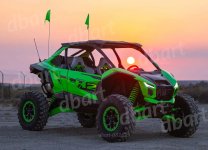Crusty
Well-known member
- Apr 29, 2021
- 6,286
- 6,829
Now to the stock cage. I’m not a fan of all the bolt on cage parts or lack of triangulation. But I was able to feel the thickness of the tubes, and if it’s not .095 then it’s close. The stock cage & chassis have 10 mounting points. I’m not a fan of how the A pillar is not inline with the A pillar mounting points. They laid it back to rake back the A pillar. IMO I would make the tube clamp and tube aline and they would stand the A pillar/windshield more upright. This would also move the upper visor roof bar more forward. Doing this you could probably add an A+ tube on the cage and tie into the chassis making it way stronger in that area. Also in some bends Kawi has added formed gussets, and in some places they welded a sleeve over the tube to add strength in that bend. I still think an aftermarket cage will look much better and offer more strength. But for stock, it’s better than many others. IMO the plastic roof is hideous. But that’s just me. I’d rather have a smooth aluminum roof panel.
View attachment 156525View attachment 156526View attachment 156527View attachment 156528
Notice the wonky angle change from the cage bung clamp and the A pillar tube. IMO they should stand up the A pillar and made both inline. Plus you might be able to add a A plus bar on a aftermarket cage.
View attachment 156529
I'll agree that "more bars and triangulation" helps strengthen a chassis, aftermarket bolt on intrusion bar for the A pillar would be a nice add.
I disagree that the A pillar angle is dangerous - only direct impact would benefit from it being inline vs the slight angle it has now. No typical crash will put force in that direction for it to be the benefit your talking about. It's an esthetic issue for you perhaps? Like Rolled roof lines vs straight...its a visual preference.
- Enthusiast speculation: Off-road forums often feature discussions based on visual assessment rather than engineering data. The A-pillar angle is visually prominent, but its performance in a rollover is determined by the specific materials, thickness, and mounting points of the entire ROPS, not just its outward appearance.






